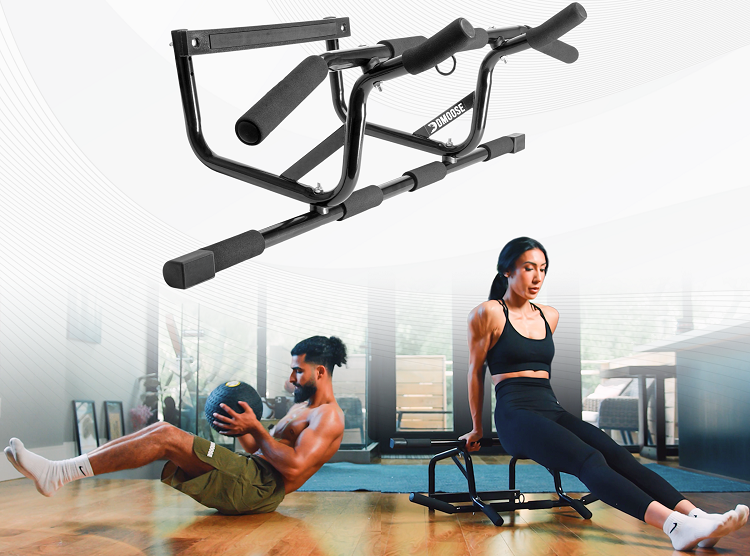You finally found time to train at home, bought a Pull Up Bar for Home, and you're pumped to crush those upper body gains. But halfway through your first set, the bar shifts or worse, pops off the frame. Sound familiar? You're not alone.
One of the most overlooked but critical details in home workouts is the Doorway Pull Up Bar weight limit. Many people assume that if it fits the doorframe, it’s good to go, but that’s not always the case. The truth is, ignoring the bar’s load capacity can lead to injuries, damaged walls, and wasted money.
In this post, we’ll walk you through everything you need to know to stay safe and confident while training at home with a doorway pull up bar.
Why the Weight Limit Matters?
Exceeding the weight limit of a pull-up bar can lead to sudden failure, causing you to fall mid-exercise. This not only puts you at risk for injuries like sprains or bruises but also endangers anyone nearby. A bar detaching from a doorframe can easily damage your walls, trim, or flooring, turning a quick workout into an expensive repair.
Even if the bar does not break immediately, consistent overloading causes gradual wear. The metal may bend, screws can loosen, and overall stability starts to decline. You might not notice anything wrong until it finally gives out when you're mid-rep.
To make matters worse, going beyond the weight limit often voids the manufacturer’s warranty. Most brands clearly state their maximum load, and any misuse typically disqualifies you from coverage. If something goes wrong, you could end up paying for both the damages and a new bar out of pocket.
Doorway Pull Up Bar Weight Limit

Most doorway pull-up bars support between 200 to 300 pounds, which is generally fine for bodyweight exercises. But when you add intensity like kipping, swinging, or wearing a weighted vest, the actual force on the bar increases.
Heavier-duty bars are built to handle more. Some can support up to 400 pounds, offering better stability for larger users or advanced workouts. These often use stronger materials and more secure mounting systems.
It’s also important to factor in dynamic weight, which is the extra force created during movement. Even if you weigh 250 pounds, a fast pull-up can put much more strain on the bar than your static weight alone.
That’s why the DMoose Doorway Pull-Up Bar is a smart choice. With a 350-pound capacity, it’s built to handle serious training while keeping you safe and supported.

What Affects the Weight Capacity?
Several factors influence the weight capacity of a doorway pull-up bar, and understanding them can help you choose the right bar and avoid accidents.
Material Quality
The type of material used plays a major role in how much weight a bar can handle. Steel bars are the strongest and most durable, while aluminum is lighter but typically supports less weight. Bars with plastic components or weak joints are more prone to cracking or bending under pressure.
Mounting Style
Bars that use a tension-based setup without screws rely on friction and bodyweight balance, which limits their capacity. In contrast, screw-in or wall-mounted bars offer better stability and can safely hold more weight. The more permanent the installation, the more support it usually provides.
Door Frame Compatibility
Not all door frames are built to hold weight. Thin wood, weak trim, or shallow molding can compromise the bar’s grip and increase the risk of slipping or damage. A solid, properly measured frame is essential for safe use.
Bar Design and Grip Distribution
The design of the bar itself, including how it distributes weight across the frame, matters. Wider bars with multiple contact points typically spread the load more evenly. This reduces stress on any single part of the frame and enhances overall safety.
Usage Style
Static holds put less strain on the bar than fast or explosive reps. Movements that involve swinging or momentum increase the effective load and test the bar’s limits more than many users realize. Always factor in how you train when choosing a bar with the right capacity.
Tips to Stay Within Safe Usage

- Check Capacity First: Always review the manufacturer’s listed weight limit before using the bar.
- Avoid Dynamic Movements: Skip swinging, kipping, or explosive reps that increase force on the bar.
- Inspect for Damage: Look for wear, loose parts, or bending before every workout.
- Assess the Doorframe: Make sure the frame is solid, properly fitted, and not showing signs of damage.
- Watch Added Weight: Only use weighted vests, gear, or any other pull up bar accessories if your total weight stays under the limit.
- Control Your Reps: Use slow, steady movements to protect both your body and the equipment.
- Educate Other Users: Make sure everyone using the bar knows the limits and safe practices.
FAQs
1. What happens if I exceed the weight limit on my doorway pull-up bar?
Exceeding the limit can cause the bar to detach unexpectedly or bend over time. Even if it holds temporarily, the structural integrity weakens with each overloaded use, increasing the risk of failure mid-rep. This could result in injuries or long-term damage.
2. Is the weight limit the same for all grip positions on a multi-grip bar?
Not always. Some grip positions place more strain on specific parts of the bar or frame, especially wide or angled grips. It’s best to stick with centered, neutral grips if you're close to the upper weight range for added stability.
3. Does dynamic movement affect the weight capacity of a pull-up bar?
Yes. Fast or explosive reps like kipping or muscle-ups can exert forces well beyond your static bodyweight. These movements increase the effective load on the bar, which is why many brands advise using them only if you’re significantly under the stated capacity.
4. How accurate are the listed weight limits on pull-up bars?
Manufacturers test under controlled conditions, so weight limits reflect static load in ideal setups. Real-world factors like uneven doorframes, improper installation, and repeated dynamic use can reduce the actual safe limit. It's wise to aim for a 20–30% buffer below the stated max if you train aggressively.
5. Can the weight limit change over time with repeated use?
Yes, frequent use, especially near the maximum limit, can gradually wear down components. Metal fatigue, joint loosening, or grip compression may lower the safe load capacity even if the bar appears intact. Regular inspection is key to spotting early signs of stress.
6. Are wall-mounted bars better than doorway bars in terms of weight capacity?
Generally, yes. Wall-mounted bars tend to offer higher weight limits and better long-term support, especially for heavier users or weighted training. However, they require permanent installation and may not be suitable for renters or those with limited space.
Conclusion
Your pull-up bar should support your strength goals, not create setbacks. Whether you’re a beginner working with bodyweight or someone adding weighted reps to the mix, knowing your equipment’s limits is essential.
Don’t risk a fall, a broken frame, or a voided warranty just because the specs weren’t clear. Take a few minutes to understand your gear. It’s a small effort that pays off in safety, progress, and peace of mind.
Ready to train smarter? Start by checking your bar’s limit, and if you’re in the market for a reliable one, the DMoose Doorway Pull Up Bar is the top-rated option built for strength and durability.











